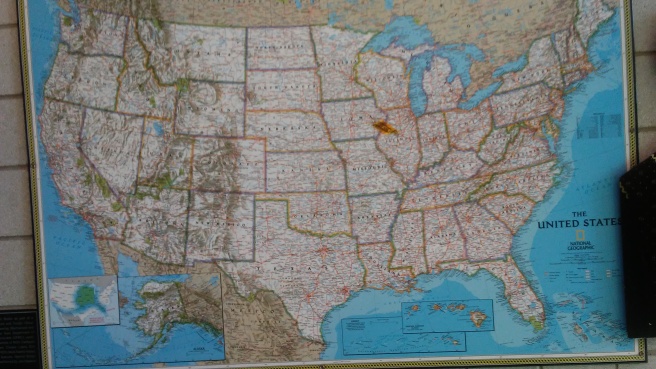
July 24 …
I am traveling along a back road through Indiana, making good time, per Robert Pirsig in Zen and the Art of Motorcycle Maintenance, the emphasis on good rather than time. With the earth is as level as a counter top, the sky is the star of the show. This will be the case all the way into Montana. Every second of the way, God changes the canvas. The scenery is never dull – you only have to look up.
In no time, I’m driving through southern Illinois. An alien object looms over the cornfields. This is one of those occasions where you need to stop and take a picture …

The land goes by many names – farmbelt, cornbelt, and so on – but the one that resonates with me is agricultural-industrial complex. Back in California, through the Imperial Valley, I was essentially driving past open-air food factories. Here in the cornbelt, the scenery is much different, but the phenomena registering along my optic nerve is essentially the same: The era of the yeoman farmer planting diverse crops is long gone. Agribusiness runs the show, monoculture is the norm. We now have the capacity to put food on every table, but at what cost?
According to the UN’s Food and Agriculture Organization, cited on Harvard’s School of Public Health, only 12 plant species provide three-fourths of our total food supply, and only 15 mammal and bird species make up nine-tenths of livestock production.
Are we a food chain collapse waiting to happen?

Later in the day, I cross the Mississippi into Davenport, Iowa. Officially, I’m back in the west, but geographically, I’m still way way east. The US is a lot broader at the top than at the bottom. A straight drive out of Boston to where I am right now is some 1,100 miles. Had I driven from Jacksonville to Baton Rouge (where I crossed the Mississippi in March) I would have put only 600 miles on the car. Eleven hundred miles out of Jacksonville would have taken me past San Antonio.
To give you a visual idea, here is a pic I took at a rest stop in Illinois earlier in the day …

Note the yellowish marker. Miles to go before I sleep. I’m starting to get worried. I can still enjoy the scenery on my trip, but one thing going wrong – mechanical problems, getting sick, existential ennui – and I am going to miss at least one didgeridoo gathering in Oregon.
Maybe it’s my mood, maybe a sense of exhaustion, but somehow the Mississippi comes across as a major anticlimax.
I resolve to put the river in my rearview and keep heading west. I have arranged to stop in at a friend’s on the northwest end of the state, near where Iowa meets Minnesota and South Dakota. A long drive is in store, and somewhere in the cornfields out there I will need to find a campground.
A couple of hours pass. It’s four in the afternoon, and I need to start thinking about where I will be spending the night. Then I pass a sign that reads:
Herbert Hoover Presidential Library and Museum

I’ve never been one to just drive past a presidential library. Minutes later, I’m stretching my legs in the parking lot, enjoying the grass and the trees. I step inside …

You can make a good case that Hoover was one of the most talented men of the 20th century. The one blot on his resume was his single term as the 31st President of the US. Adventurer, scholar, humanitarian, Herbert Hoover led a life of one sterling accomplishment after another, only to be cast as a scapegoat for the Great Depression.
Fewer men entered the office with higher expectations. As a boy he rose from poverty and entered Stanford, where he studied geology. As a mining engineer, he discovered gold in Kalgoorlie, Australia, then, with his new wife, ventured into China in time to experience the Boxer Rebellion, then made his fortune in worldwide mining interests. During the outbreak of World War I, he organized an unprecedented relief effort for starving Belgians. When the US entered the War, he headed up the US Food Administration. After the Armistice, he spearheaded post-War relief efforts. The Soviet author Maxim Gorky credited him with saving millions of Russians from death.
His stint as a progressive and innovative Secretary of Commerce under Harding and Coolidge made him a natural for Presidential office. Greatness was written all over him. Alas! Stock market crash and Great Depression. The scope of the catastrophe was unprecedented, as was the speed at which the economy unraveled. Old solutions did not work, new ones did not exist. It was not just a national disaster, but a world disaster. Whatever happened in Europe also affected the US. And vice-versa.
History tells us that it took a man of FDR’s caliber to solve the banking crisis and lead us out of the Great Depression. But the facts are way too complicated. Back in 1929, forces that we barely understood overwhelmed the world. The best individual to handle the situation at the time was already on the job. Here he was, a man of immense talent, head and shoulders above the rest. Alas, he was no superman.
It kind of makes you wonder: Should we have another catastrophe – say, a food chain collapse, say runaway weather – who is going to lead us? Who is going to come to the rescue? Listen to history – Herbert Hoover is giving us a powerful lesson.

Frightening but true. Will the world hear the wake up call? Keep the faith.
LikeLike